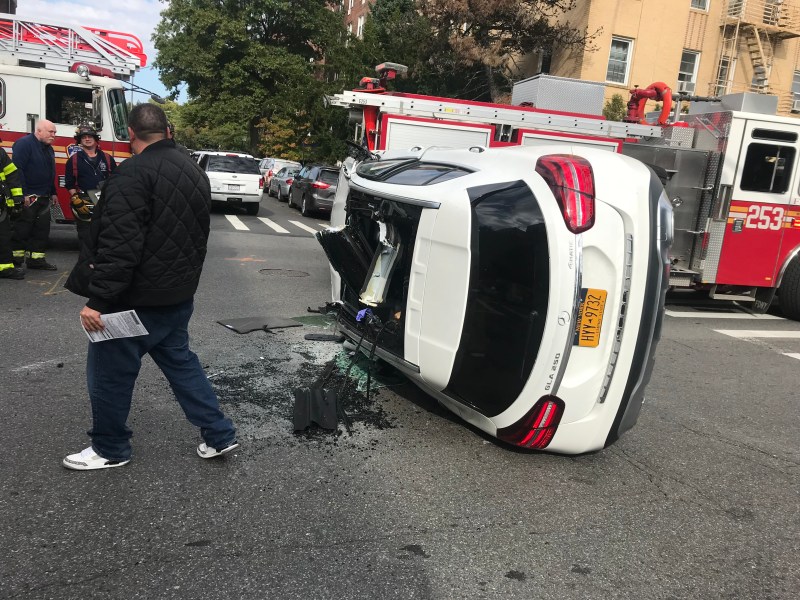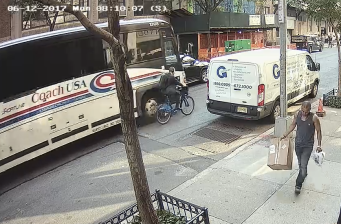Manhattan Pol Wants To Change State Law To Hold Reckless Drivers Accountable
Assembly Member Dan Quart's proposal would change a single word to make a big difference.

A Manhattan state pol believes that changing a single word in state law could make a huge difference in finally holding reckless drivers accountable by eliminating the need to prove that the driver intended to kill or injure people.
Assembly Member Dan Quart plans to introduce legislation this month that would change the word “reckless” to the word “aggressive” within the state’s vehicular code — a change that could prevent judges from believing that prosecutors need to prove intent to get a conviction rather than just showing carelessness by a driver.

“Hundreds of New Yorkers are killed every year because of dangerous driving,” said Quart, who is running for Manhattan District Attorney. “This bill will make it clear to the courts that aggressive driving is illegal and that aggressive drivers must be held accountable.”
It’s only one word — but it’s a key one. Substituting “aggressive” for “reckless” would eliminate years of caselaw and judicial custom that requires prosecutors to prove that a driver was aware of his or her misconduct when driving a car into someone — a premeditation known in criminal law as mens rea. But using the word “aggressive” could eliminate the need to prove mens rea because the standard would merely be bad driving, not willful intent.
“Judges have been interpreting the statute to require the level of culpability that is reckless, so even if you do something any of us consider to be reckless driving — cutting off someone riding a bike, or driving in the bike lane — judges have said it doesn’t fall into reckless driving,” said Quart’s Chief of Staff Amanda Wallwin. “So we’re going to make it clear that when we say ‘reckless driving,’ we mean ‘dangerous driving.’ We don’t mean with the intent to cause harm.”
Here is the law change in full (with the proposed changes in strikethrough text):
RecklessAggressive driving.RecklessAggressive driving shall mean driving or using any motor vehicle, motorcycle or any other vehicle propelled by any power other than muscular power or any appliance or accessory thereof in a manner which unreasonably interferes with the free and proper use of the public highway, or unreasonably endangers users of the public highway.RecklessAggressive driving is prohibited. Every person violating this provision shall be guilty of a misdemeanor.
The current language helps absolve many drivers that any reasonable person would otherwise consider to be driving recklessly. For example, if a driver veers into the bike lane or hits a pedestrian in the crosswalk, a prosecutor would have to prove that the driver intended to do it — which is not only typically not the case, but is also difficult to prove even when it is.
This kind of thing comes up all the time when prosecutors weigh whether to charge a driver criminally if he, say, runs a red light and kills someone. If running the red light is the only “crime,” the driver is very rarely charged. Earlier this year, Brooklyn DA spokesman Oren Yaniv took to Twitter to explain why:
I will promise you a fair and thorough investigation. As you know, merely running a red light does not amount the criminal negligence in NY case law (see: https://t.co/iHB8MejbSd for explainer).
— Oren Yaniv (@OrenYaniv) August 12, 2019
Yaniv was debating street safety advocates in the hours after cyclist Jose Alzorriz was run down and killed by a driver who had run a red light. Initially, it was unclear if Brooklyn DA Eric Gonzalez would charge the driver, but investigators eventually threw the whole summons book at driver Mirza Baig.
But more often, instead of a charge of manslaughter or criminally negligent homicide, some killer drivers walk away with as little as a fine for “failure to exercise due care” for killing a human being.
Or even less — the truck driver who hit and killed 20-year-old Robyn Hightman in Manhattan back in June got a sympathetic pat on the back from officers before they let him go.
The lack of charges was all too familiar for other families whose loved ones were also killed by drivers almost entirely let off the hook.
Brooklyn District Attorney declined to press charges against the hit-and-run truck driver who killed 25-year-old Aurilla Lawrence in Williamsburg back in February, citing insufficient evidence to convince a jury of the driver’s reckless intent.
Years before that, Brooklyn prosecutors never pressed charges against the driver who hit and killed 12-year-old Sammy Cohen Eckstein, despite the state’s Department of Motor Vehicles suspending the driver’s license for six months for failing to exercise due care and for not having a valid license at the time of the crash. Former Queens DA Richard Brown similarly declined to charge the driver who hit and killed 3-year-old Allison Liao.
In 2015, both Liao and Cohen Eckstein’s families joined dozens of others in a rally on the steps of City Hall to demand the city’s five District Attorneys do their jobs and prosecute drivers for killing their children even if they didn’t intend to.
“It is not an ‘accident’ when drivers make turns at full speed without even looking. It is not an ‘accident’ when drivers speed through intersections and kill people,” Cohen said at the time. “We will never get to zero fatalities unless we hold dangerous drivers accountable. The five New York City district attorneys have failed to do their jobs.”
“Hopefully that will allow judges to really put the statute into effect the way we think is important and what safe-street activists think is important,” said Wallwin, the chief of staff. “Use it to really hold drivers accountable when they are behaving in a way any average person would consider as reckless but people who think of this legally do not define as reckless.”
The state pol said he consulted attorney Steve Vaccaro to help craft the legislation in order to hold more drivers’ accountable.
It’s not enough for drivers to only be charged with reckless driving in clear-cut situations where it’s easy for a prosecutor to prove intent — drivers who fail to see what’s in front of them on the road, especially in crosswalks, must also be held responsible for their poor and dangerous choices behind the wheel, said Vaccaro, who has previously written for Streetsblog about how law enforcement weakly enforces the Reckless Driving statute.
“The underlying notion of a misdemeanor for reckless driving is it puts people on notice that the streets are full of pedestrians and cyclists, and not seeing them is no excuse for escaping criminal liability,” he said. “The reason police don’t charge for hitting in a crosswalk, it doesn’t automatically fall into a slam dunk zone. We got to change the way those scenarios are analyzed and that’s what this is about.”





